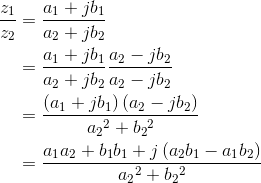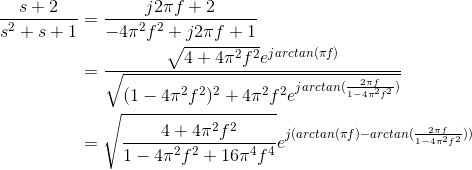Adding and subtracting complex numbers expressed in Cartesian form is quite easy: You add (subtract) the real parts and imaginary parts separately.

To multiply two complex numbers in Cartesian form is not quite as easy, but follows directly from following the usual rules of arithmetic.

Note that we are, in a sense, multiplying two vectors to obtain another vector. Complex arithmetic provides a unique way of defining vector multiplication.
Exercise 2.1.3
What is the product of a complex number and its conjugate?
Division requires mathematical manipulation. We convert the division problem into a multiplication problem by multiplying both the numerator and denominator by the conjugate of the
denominator.

Because the final result is so complicated, it's best to remember how to perform division multiplying numerator and denominator by the complex conjugate of the denominator than trying to remember the final result.
The properties of the exponential make calculating the product and ratio of two complex numbers much simpler when the numbers are expressed in polar form.


To multiply, the radius equals the product of the radii and the angle the sum of the angles. To divide, the radius equals the ratio of the radii and the angle the difference of the angles. When the original complex numbers are in Cartesian form, it's usually worth translating into polar form, then performing the multiplication or division (especially in the case of the latter). Addition and subtraction of polar forms amounts to converting to Cartesian form, performing the arithmetic operation, and converting back to polar form.
Example 2.1
When we solve circuit problems, the crucial quantity, known as a transfer function, will always be expressed as the ratio of polynomials in the variable s = j2πf. What we'll need to
understand the circuit's effect is the transfer function in polar form. For instance, suppose the transfer function equals


Performing the required division is most easily accomplished by first expressing the numerator and denominator each in polar form, then calculating the ratio. Thus,

- 瀏覽次數:4688






